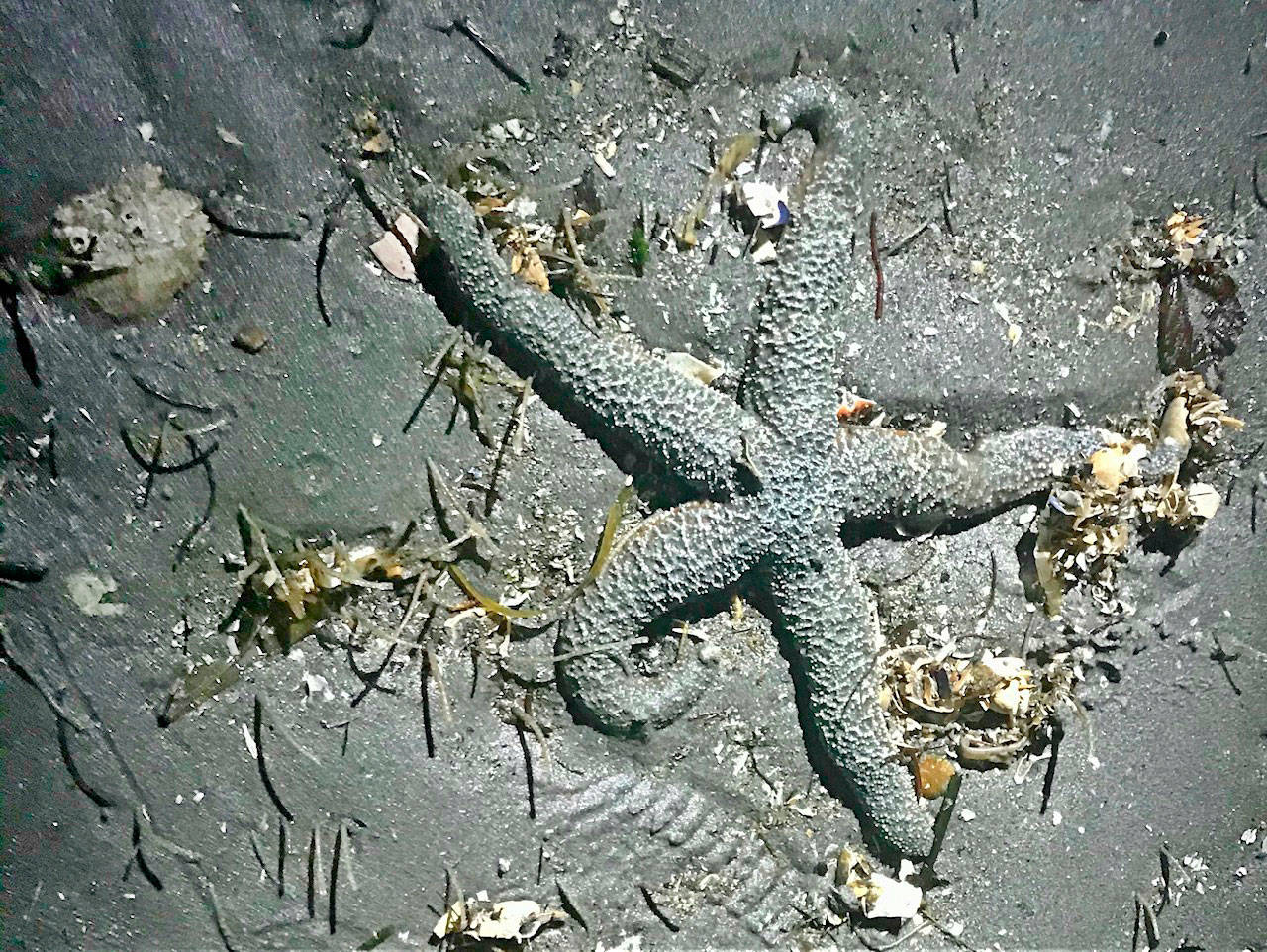This version of the article has been updated.
Last Friday, more than 60 islanders braved the wind and rain with flashlights in tow, combing the shore at the north end for sea creatures revealed by the low tide, seemingly a world away from the busy ferry dock nearby.
They were taking part in the annual Low Tide Moonlight Beach Walk, led by beach naturalists and the Vashon Nature Center, looking for sea stars, crabs, chitons, limpets, anemones and nudibranchs under the moonlight that longtime naturalist Rayna Holtz said still shone in spite of the cloud cover overhead.
“Very often, even though it was raining in our little part of the world, you could look southward toward the sky over Tacoma and you could see the moon, the full moon, shining through a misty layer of rain,” said Holtz.
Among the marine life observable in the low tide were several different kinds of chitons and the small, bright Cucumaria miniata sea cucumber, more than any Holtz could remember from past moonlight walks.
“I don’t remember seeing so many. That was one of the most numerous species this year,” she said.
There were brilliant anemones such as the aptly named Christmas anemone, consisting of a thick stalk striped red and green, topped by a crown of tentacles like a lion’s mane. Under rocks, said Holtz, islanders saw tunnels dug by spaghetti worms attached to the underside, which use long, fine filaments to search blindly for food. Holtz said she saw porcelain crabs, as fragile and delicate as teacups, with flat and smooth claws that live in crevices but are extremely delicate. One of their survival strategies is to readily lose a limb if something grabs it. Another crab that was seen was the blue/purple Lophopanopeus bellus, or black-clawed crab, often found in lower beach habitats.
“This little crab is very pugnacious. It will stand right up and put both of its claws up even though it’s tiny,” she said.
Other sightings included many frilled dog winkle sea snails congregating on rocks near and under the dock — Holtz noted it will soon be the beginning of their nesting season when they will lay their eggs on rocks and pilings. There were barnacle eating dorid nudibranchs, three-spined stickleback fish and gunnels, all favorites of blue heron and sandpiper shorebirds. Holtz also said that she was excited to see several lacuna sea snails on the eelgrass beds where they settle.
“They’re beautiful, they’re amber, little translucent amber. They’re tiny,” she said. “When you get to -3 [foot tide], then there’s great, huge beds of eelgrass. If you go slowly and carefully you’ll see all kinds of things in the eelgrass bed, but it’s not good to walk right into them. It’s good to walk along the edge of them.”
Holtz said she was encouraged to find a number of mottled sea stars, with none suffering the obvious effects of a devastating wasting disease that first broke out across species of sea stars in 2013. Symptoms begin as lesions in their skin, ultimately atomizing the animals, pulling them apart until they melt. But she noted that there were no purple ochre stars, once among the most numerous, congregating with bright maroon, orange, and purple stars on the dock pilings.
The wasting disease was especially hard on sun sea stars — once able to grow to sizes as large as manhole covers, they have not significantly recovered in the waters of the west coast in the ensuing years since the disease first proliferated, though there are signs that other species are beginning to make a comeback.
Holtz said that ten years ago it would be easy to see as much as 80 or 100 purple/ochre stars under the dock, with 30 to 35 mottled stars and 20 sun stars, numbers that don’t occur today.
Bianca Perla, director of the nature center, said she was also heartened to see more mottled sea starts than the year before, including juveniles, and added that several participants of the low tide walk claimed they saw a sun star, though she could not confirm their sighting.
Though she isn’t sure, Perla said she believes that change has gradually come to the tidal waters of Puget Sound, with fewer species of marine life on island beaches at low tide compared to 20 years ago.
“I don’t think necessarily there’s just one cause for it. I think it’s a million different things that are contributing to just generally lower abundance,” she said.
But Perla said that is not enough to dull the magic of the winter tide walk tradition, where even the elements could not deter families with excited children dressed in raincoats and wearing thick boots kneeling in the mud, later sharing stories of all that they had found.
“It’s beautiful to be out there, it’s magic out there,” she said. “Just being out in nature a lot, I know it just seems to reward you when you go out there. Despite the cold and the wet, you just seem to forget about it.”



